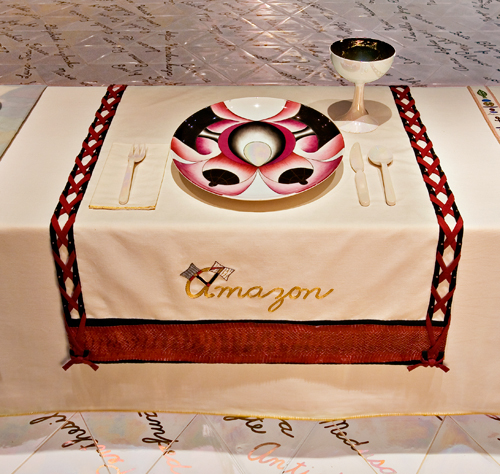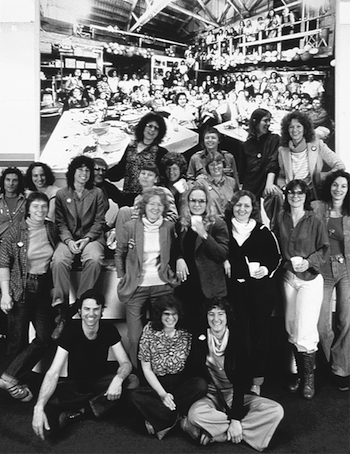“First Encounters with the Second Wave” by Eleanor Whitney
“And She Gathered All before Her
And She made for them A Sign to See
And lo They saw a Vision…”
 Judy Chicago (American, born 1939). The Dinner Party, 1974–79. Ceramic, porcelain, textile, 576 × 576 in. (1463 × 1463 cm). Brooklyn Museum, Gift of the Elizabeth A. Sackler Foundation, 2002.10. © Judy Chicago. (Photo: Donald Woodman)
Judy Chicago (American, born 1939). The Dinner Party, 1974–79. Ceramic, porcelain, textile, 576 × 576 in. (1463 × 1463 cm). Brooklyn Museum, Gift of the Elizabeth A. Sackler Foundation, 2002.10. © Judy Chicago. (Photo: Donald Woodman)
“Damn,” I whispered to my best friend Lauren as we walked through a dark hallway at the Brooklyn Museum. “What is this?”
And then we were upon it. The Dinner Party, Judy Chicago’s iconic, room-sized feminist art oeuvre loomed in front of us. A massive triangular table glistening with ornate ceramic plates and chalices that seemed to hover above their embroidered table runners while a pearlescent glow emanated from the tiled floor below. I stopped dutifully in front of the first place setting, the Primordial Goddess. I contemplated the china plate with a deep red streak running through its center. I moved on to the next plate, for Kali, whose opening revealed further folds, like eggs or teeth. Next to her the Amazon’s plate was flanked with glinting silver axes and gilded nipples, for their armor I presumed. I worked my way around the table. Emily Dickinson was frozen in pink, frilly lace, and Margaret Sanger’s plate glowered a throbbing, bright red, with bulbous, ceramic curves that urgently reached towards me.
I tried to make out the names of women that spilled, in gilded calligraphy, across the pearly floor.
“Nefertiti, Mary Magdalene, Juana de la Cruz, Radclyffe Hall,” I mumbled and then, in clear script, just near one of the triangle’s points, “Copyright Judy Chicago 1979.”
Lauren sidled over to me and, forming her fingers into a triangle, placed them over her lower abdomen. I did the same. It was the sign we used to indicate when we thought something was a product of essentialist, second wave feminism, imitating the ancient symbol for the vagina.
“Yoni,” she looked at me, raising her eyebrows.
“Totally yoni,” I replied.
“So many white women,” Lauren, who was Chinese-American and Jewish, pointed out. “A whole table full of white women. Most of the non-western women at the table were mythical goddesses. Because that’s what we women of color are good for in the eyes of white people. Exotic, ancient, and imaginary.”
To us, in our early and mid-twenties in the early 2000s, the ideas that inspired second wave feminists during the 1960s and 70s were already dusty museum pieces, even though sexism in the art world, and the world at large, was not. Lauren and I had come to feminist consciousness during the 1990s Riot Grrrl era and forged our idea of feminism around the “third” wave: understanding the intersectionality of identities and movements, critiquing the power held by white feminists, and moving away from the idea that all women were essentially the same because of shared anatomy (or even that it was necessary to share anatomy to be a woman) and towards a postmodern understanding of gender and womanhood as a construct.
Three years later, I joined the education staff at the Brooklyn Museum. A believer in the radical possibility of art and cultural education, I was excited to use the museum’s collection, including The Dinner Party as a way to open up dialogue around inequity and social justice. As an educator for high-school and college groups, I found myself spending hours with the piece while I researched and wrote curriculum for teachers and lead tours for students, often brought by professors who were enthusiastic white women with greying hair.
Housed in a freshly redesigned, triangle-shaped gallery, The Dinner Party seemed to float on a black floor with lights like stars reflecting off the dark, smoke colored glass walls. The ceramic plates shone with a gauzy glow as I slowly led the students in a single file line past the place settings for the Primordial Goddess, the Snake Goddess, the Amazon, and Kali before pausing in front of Pharaoh Hatshepsut’s seat at the table. I heard the students stifling giggles as they realized what the central designs of the plates represented, and, taking a deep breath I asked, “So, what have you noticed about the piece so far?”
As we swung around to the final wing of the table I stopped every group in front of Sojourner Truth’s plate. By this time my students had often remarked that they had not heard of many of the women at the table and discussed why. A few of the savvier students had begun to ask, “Where are the Asian, Latina, and African women?” but as the sole black woman at the table, Sojourner Truth’s plate drove the fact that the women invited to The Dinner Party were mostly white, western, or mythological.
“Who do you think has been excluded from The Dinner Party?” I asked, inviting a critical conversation about how even when making a statement about women’s historical and artistic erasure, the piece still reflected the artist’s biases, as well as the dearth of information available on non-Western women at the time the piece was created in the late 1970s.
At first, I felt embarrassed that any of the students on my tours would associate me with The Dinner Party and the seemingly outdated ideas it represented. I desperately wanted to be connected to a younger, hipper, and more intersectional approach to feminist thinking and art making. However, after months of studying the piece, learning about its creation, and talking about it with hundreds of people, I started to feel an odd sense of protectiveness, and even ownership, over it, perhaps trying to justify the sheer number of hours I spent with it.
I was not alone in my discomfort about the piece or my feelings of protectiveness of it. I soon found that the piece remained a point of feminist controversy not only for the ceramic vulvas, essentialist idea of women, or the exclusion of women of color. It also had another history of erasure.
The construction of the piece had relied on the volunteer labor and support of over 300 artists and community members: Ceramicists, fabricators, needleworkers, and studio administrators among others, they researched the women who were honored at the table, wove the tapestries for the entry banners, and embroidered the intricate table runners. They helped sculpt, paint, and fire the oversize china plates and built the frame for the table. A photo from the studio shows a large group of white women, and several men, smiling with feathered 70s hair and oversized blazers. Their work drew comparisons to a renaissance atelier with Chicago acknowledging, “The studio gradually became a structure of self-sufficient groups working under my guidance while also building teamwork through shared responsibility and honest dialogue.” And yet it was Judy Chicago’s name and copyright that was on the piece, causing resentment among the hundreds of artists who had collaborated with her.
All of this had seemed to me like long-mothballed feminist gossip, but during a public conversation between Chicago and Elizabeth Sackler, a board member at the Brooklyn Museum, a benefactor of The Dinner Party’s installation at the museum, and a long-time friend of Chicago’s. Chicago perched her diminutive frame in an armchair on the museum’s large auditorium stage, her orange red hair fanning out like a fiery mane, wearing dark glasses and brown lipstick. I hovered in the back, making sure the auditorium doors didn’t slam as people entered and existed. During the question and answer period a woman with a greying ponytail sitting in the front row stood up and demanded, “Where are the acknowledgement panels? In every other exhibition the names of the people who worked on The Dinner Party have been displayed with it and now our work, our labor, has been erased. This was a community effort, and the artists have been demanding greater recognition for years!”
Judy Chicago zeroed in on her like hawk. At the back of the auditorium I held my breath.
“Listen, Marilyn,” she began, her voice pitched and commanding, “This piece is my vision. Everything that went on The Dinner Party I directed or designed. It’s mine.”
“Women have been erased from history once again!” declared Marilyn, “Shame on you and shame on the Brooklyn Museum!”
She grabbed her coat and stalked up the auditorium’s aisle, while I sheepishly opened the door as she stormed out.
I thought about how, when Lauren and I had first saw the piece, we thought that the ideas, artists, activists, and ideals of second wave feminism were confined to history. Many of the people who shaped the movement, I realized, were still very much alive and active. I wondered how a monumental piece like The Dinner Party had frozen them and our contemporary ideas about the feminist movement during the seventies in time and and reduced it to a few simple talking points: essentialist, exclusionary of women of color, kitschy.
I’ve long since moved on from working at the Brooklyn Museum, but on the decade since I worked with The Dinner Party daily, I realized how much I am indebted to feminist art and the artists of an older generation I previously wrote off. At that time my radical artist friends and I formed collectives to show and produce art; protested the exclusion of women, people of color, and LGBTQ people from mainstream art institutions; pushed to elevate “craft” to the status of fine art; and used discarded materials, our bodies, and performance as art—all of which feminist artists of the 60s, 70s, and 80s had done long before us.
Like contemporary feminism, second wave feminism was anything but monolithic, all-white, straight, humorless or only attuned to the needs of middle class women: Faith Ringgold demonstrated that quilting was a form of fine art; Adrian Piper helped define and illustrate the idea of gender and race as performance; Lynda Benglis skewered the male art world with her full page ad in Art Forum showing her naked, greased, tan body brandishing an oversized dildo; organizations like Black Women Artists and the Lesbian Art Project organized group shows and performances and pushed for art by women of color and queer artists to be taken seriously; collectives like the Women’s Action Coalition and, of course, the Guerrilla Girls, used costumes and humorous rallying calls to draw attention to the lack of representation of women in major galleries and museums and the economic disparities between men and women artists. Us snotty punks, of course, thought we invented these tactics, but we were really continuing a conversation started by artists generations before.
Yet feminism, and the rights of women, are still continuously under assault. The contemporary movements that have formed to push back against the current restrictive and punitive policies of the US that imagine a brighter, more egalitarian future, such as Black Lives Matter and even the 2017 Women’s March, are not unlike much of the women’s art movement in the 60s and 70s. These movements came out of grassroots organizing and community activation before they were endorsed and supported by the cultural elite. While I believe that feminist artists have a right to support their lives from their work, I also believe feminism and feminist art must stay closer to this revolutionary, scrappy, on-the-ground spirit. The art feminists create must imagine, and model, the future. This art must continue to nurture those intimate, evolving, community-minded spaces that incubated radical feminist thought for so long, and fight back against attacks on our communities.
I love feminist art because it is bold, complicated, messy, grandiose, and intimate. It makes us rethink our assumptions and look at the world differently. It bothers us and sticks with us and motivates us to action. It pushes us to ask for more and envision a more just world—a dinner party, a picnic, a performance, a movement, a government, a revolution where we’re all invited and all contribute. The Dinner Party was not the first piece of explicitly “feminist” art I saw or spent time with. However, though I’m hesitant to admit it, it has become one of the most influential pieces of art in my life. Not because it taught me about women’s history or the fact women could be artists and create oeuvres on par with, and more impressive than, men. This I already knew. But it was my very dislike of the piece, the fact that it had a presence and was a force and a problem to be reckoned with that simply won’t go away that has made it stick with me. It’s gotten under my skin. I may not like it, but as a cultural object it is effective. It challenges me to come up with alternatives—don’t like it? What would you do differently? It’s shining, pearlescent hulk challenges me—how will you put your voice and version of feminism out in the world?
My ears still prick up when I hear strangers talking about the The Dinner Party and I have to resist the urge to butt into their conversation and ask, “Who do you think was left out?”









